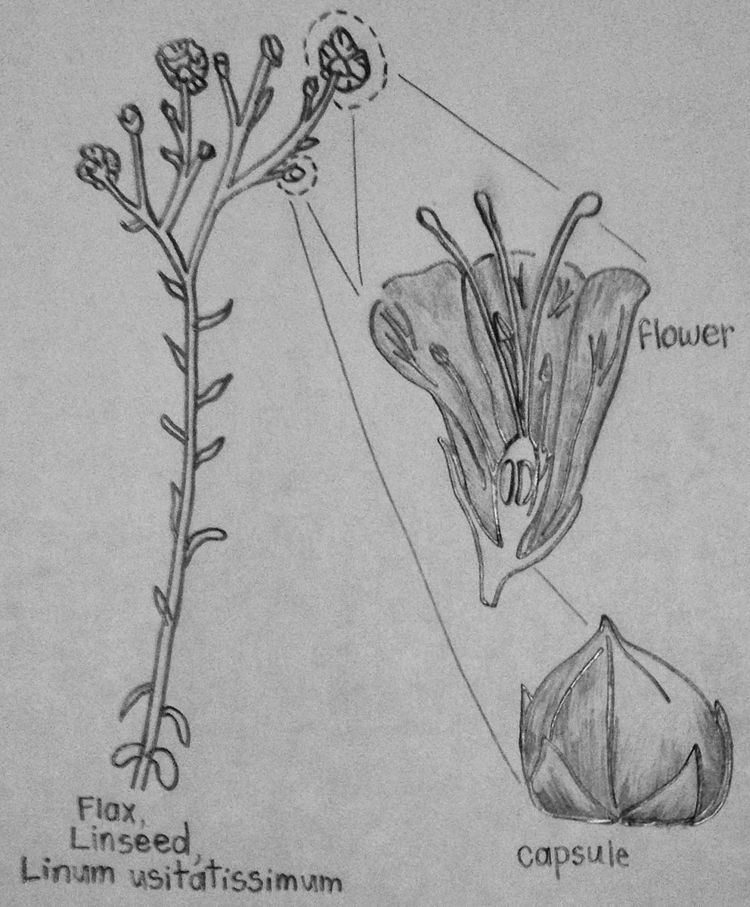 | ||
The production of flax (Linum usitatissimum) and other oilseed crops peak in the temperate climates of the middle mountain and hill farming regions in Nepal. Flax matures in approximately 90 to 125 days and develops most rapidly under the cool, short-season of growing. The middle hill region of the Lamjung district, also the epicenter of the earthquake devastating Nepal in April 2015, exemplifies an ideal climate for flax production experiencing consistently cool temperatures for most of the year. The shallow rooting system makes the plant especially susceptible to drought and excess moisture in the soil but also easier come time to harvest. Most cash crops are grown in the hill regions of Nepal as this is where two thirds of the subsistence farmers reside whom need to produce just enough food to feed themselves and their families.
Contents
Production
Oilseed production in Nepal was largely replaced by grain crops which contain a higher caloric value but requires higher labor and overall decrease in nutritional quality for the Nepalese [5]. Flax production is seen to be increasing as Nepal’s reported yields in 2012 are 5000 Hg/Ha an 5358 Hg/Ha in 2013 referring to a production quantity of 7500 tons and 7672 tons respectively. The cool and temperate climate of the mid-hill regions in Nepal present great potential for farmers to maximize their linseed yields and the yield of proceeding cash-crops through disease and pest control. The hill regions of the Lamjung district is less than 170 km away from the capital of Nepal, Kathmandu, which also represents an ideal market for trading of the flax seeds or any by-products of the crop made by Nepalese farmers and their families.
Graphed data from http://faostat.fao.org/
Crop rotation
Entering flax into the crop rotation reduces the prevalence of disease and pests as flax varieties are less susceptible to diseases such as Sclerotinia stem rot, flea beetles, and certain species of Fusarium that devastate cereal crops. Further utilization of flax production will not only increase the yields of other grain crash crops but also provide Nepalese farmers with by-products for personal use or sale.
Whole flax straw
Whole flax straw holds great agricultural value to subsistence farmers. When left on the field, the straw will protect the soil from wind and water erosion and can also be used as livestock bedding or mulch. Due to the topography of the hill and mountains, run-off and erosion is of concern where whole flax straw can help to alleviate and reduce the occurrence of this erosion. Additionally, remnants of the straw and fibre remaining on the soil will return nutrients to the soil in hopes of increasing soil fertility and in turn increasing future cash crop yields. Lastly, deforestation for fuel use is an ongoing issue in Nepal. Considering that by-products of flax harvest are already used as biofuel source in Canada, this methodology can be transposed in Nepal and lessen the need for the hill and mountain farmers to scavenge for wood sourced fuels.
Flax fiber
There is world market demand for flax straw and fibre use in environmentally friendly products, textiles and biofuel. Farmers often maximize their cash returns in producing quality seed and neglect the production of whole straw and fibre; an excellent opportunity for Nepalese farmers to fill the niche market. Flax fibre can be used in textiles such as linen and cottonized flax, in pulp sweeteners as well as insulation where there is remarkable demand. Environmentally friendly products are becoming more and more popular around the world. For example, plastic composites using flax fibers are continuing to become more popular in the modern world’s automotive industry. Productions of composites require less energy than fiberglass to process and manufacture which results in a lighter vehicle that is more efficient.
Shive
Shive is the non-fibre parts of the stem and comprises anywhere from 70-85% of the total straw weight and therefore a major by-product of flax straw processing. Destined for use in bio-fuel, mulch and animal bedding.
Nutrition
Flaxseed oil is high in alpha linoleic fatty acid (ALA) of which is important to human and animal nutrition. The flaxseed itself can be consumed by the population and with its’ short maturation period and self-pollination, the crop can produce multiple cuts of straw and seeds. A versatile crop, the flaxseed can be used in breads and cereals as well as oil for supplementation as it is a great source of micronutrients, ALA and fibre.
Harvest
Harvesting whole flax straw and fibre can be a challenge. Whole flax straw is historically left in the field to decay over time or raked into piles and burned as it tends to clog farm equipment and thus makes collection difficult. As a result, harvest and post-harvest labor may be lengthy and time consuming if the straw and fibers are constantly clogging the discs of the plow.
Transport and storage
Another challenge will be the transport and storage of the flaxseed once harvested. Purchasing price from manufacturers and processing plants is largely dependent on quality where there are few grading guidelines established in Canada. Although the climactic regions of Nepal are ideal for flax production, spoilage may be an issue with increased temperatures and humidity that may be associated with transport and time of season. Transporting the materials to Canada is going to come as a cost deduction in spot price to Nepalese farmers and this may ultimately determine the profitability of the linseed crop to the farmer.
